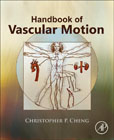
Handbook of Vascular Motion provides a comprehensive review of the strategies and methods to quantify vascular motion and deformations relevant for cardiovascular device design and mechanical durability evaluation. It also explains the current state of knowledge of vascular beds that are particularly important for the medical device industry. Finally, it explores the application of vascular motion to computational simulations, benchtop testing, and fatigue analysis, as well as implications on clinical outcomes, product development, and business. Describes methods to quantify vascular motion and deformations including choosing what data to collect, relevant medical imaging, image processing, geometric modeling, and deformation quantification techniques. Includes deformations for vascular beds of particular importance in medical devices including the coronary arteries and heart, arteries of the head and neck, thoracic aorta and arch branches, abdominal aorta and visceral branches, lower extremity arteries, inferior vena cava, and lower extremity veins. Explains how to convert raw deformations into boundary conditions suitable for durability evaluation, provides examples of using this information for computational simulations, benchtop testing, and fatigue analysis, and illustrates examples of how vascular motion affect clinical outcomes, product development, and business. INDICE: 1. Introduction Part I Methods for Quantifying Vascular Deformations 2. Deciding What You Need and How to Get It 3. Medical Imaging Modalities and Protocols 4. Geometric Modeling 5. Centerline Deformation Metrics 6. Surface Deformation Metrics Part II Deformations of Vascular Beds Relevant for Medical Devices 7. Coronary Blood Vessels 8. Neurovascular Blood Vessels 9. Thoracic Aorta and Arch Branches 10. Abdominal Aorta and Visceral Arteries 11. Lower Extremity Arteries 12. Inferior Vena Cava and Lower Extremity Veins 13. Upper Extremity Blood Vessels Part III Developing and Utilizing Boundary Conditions 14. Developing Boundary Conditions for Durability Evaluation 15. Summary of Durability Evaluation Methods 16. How to Improve Durability in a Pinch 17. Areas of Future Research 18. Conclusions
- ISBN: 978-0-12-815713-8
- Editorial: Academic Press
- Encuadernacion: Rústica
- Páginas: 240
- Fecha Publicación: 01/06/2019
- Nº Volúmenes: 1
- Idioma: Inglés
